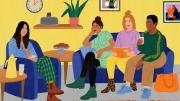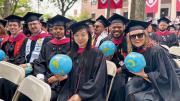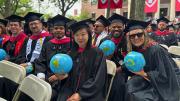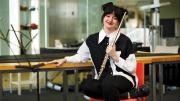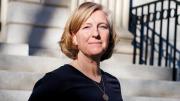On First-Year Family Weekend the fall of my sophomore year, a lone father wandered down the steep concrete stairs of Canaday Hall and through the basement doors into the Harvard College Women’s Center. As a part-time intern, I was there to answer questions from curious parents about what we do.
The father carefully examined our walls, filled with students’ artistic depictions of our concept “Gender Is a Constellation,” colorful posters of groundbreaking women in STEM, and a treasured signed photo of transgender actress and activist Laverne Cox from her talk on campus in 2014. On the table beside a large tray of assorted safer-sex supplies, our signature combination of freshly baked cookies and assorted Trader Joe’s teas was laid out to nourish visitors: on any given day, students pass through our space to fill their mugs with coffee or tea on the way to a morning lecture, or nap on the couches between classes.
“This is wonderful, don’t get me wrong,” the father said to me, finally. “But I just can’t believe that Harvard in this day and age still needs a women’s center.”
The critical work taking place in our basement space sometimes seems to escape visitors, friends, and family members, who hold preconceived ideas of what a “women’s center” might be. Are we a shelter? A sorority? A women’s health clinic?
Gender inequity and the role of our space have certainly changed since the first women’s center opened at Harvard-Radcliffe in 1971. The 1970s saw a nationwide growth of campus women’s centers as a result of a growing feminist movement and student activism. Given the historical exclusion of women from universities, the new centers centralized resources related to sexual health and daycare, while providing a physical space for women to meet, disseminate information, and organize for gender equity on and off campus.
Nearly 50 years later, part of that father’s confusion likely stemmed from the following facts: Harvard and Radcliffe Colleges officially merged in 1999, and today, women constitute 48 percent of the undergraduate population. Six iterations after the center’s initial founding, its current incarnation was established in 2006, seemingly after great strides in gender equality on campus. So why did Harvard still need a Women’s Center?
When I posed the question to another intern and two of my bosses, they each answered without hesitation, “That question itself is exactly why we need a Women’s Center.” If that father had never stumbled upon our space, I wondered, would he ever have considered what it’s like to be a woman-identifying student at Harvard today? Across the University, women hold just 31 percent of tenured and tenure-track faculty positions. Women are underrepresented among students concentrating in STEM fields. Among undergraduates, 32.5 percent of women (and 11.4 percent of men) have reported some type of nonconsensual sexual contact. The pervasive gender inequity that ignited the movement to establish women’s centers in the 1970s has not fully disappeared.
The feminism guiding our work at the center has evolved since the twentieth century to address inequity beyond comparisons between men and women. After all, not all women were assigned “female” at birth. As a women’s center, we often reckon with how to serve and empower non-binary students who don’t identify as either “man” or “woman” and more generally, transgender or genderqueer students who don’t identify with the gender they were assigned at birth. These students often face additional barriers and marginalization that get erased in conversations about gender inequity or the experiences of women on campus.
Thinking about gender and womanhood that way also benefits someone like me, assigned “female” at birth and identifying as a “woman” today. When I give “Gender 101: Beyond the Binary” workshops to students, faculty, and staff, I bring everyone into the conversation to show how often we do not neatly map onto categories of biological sex or common gender stereotypes. I am not a woman simply because I was assigned “female” at birth or simply because I like wearing makeup and have certain anatomical body parts. Nor am I a woman despite my love for beer or my ability to be a leader. I am a woman for all of the reasons I choose to be, and the bits and pieces that make up my own definition of womanhood are shaped by the ways I inhabit this world as a Harvard student, a daughter of Korean immigrants, an American, and more.
The success of twentieth-century feminism has enabled young women like me to attend an integrated Harvard College and enter Harvard’s traditionally masculine spheres and spaces. Yet these same spaces often undervalue traditionally feminine traits like emotional care—an important expression of my personal identity as a woman. The Women’s Center’s emphasis on community care and emotional well-being is sometimes dismissed as “fluff.” But that care has been critical to fostering a feeling of belonging on this campus that is often overlooked in University discussions about “inclusion” or “belonging.”
The center’s director, Heidi Wickersham, agrees. “There’s that tangible aspect we can quantify—in the access to opportunities and development fostered by our Women in STEM program, for example,” she acknowledges. “But how do you quantify the feeling of the space? It’s hard to describe that intangible essence of what we do.”
Part of that intangible essence is a deep sense of community and belonging based on shared values of equity, justice, and empathy. The numbers in the center’s annual report may fail to capture its comforting care, but I feel it through the famous hugs of Bridget Duffy, the department administrator of the College’s Office of Equity, Diversity, and Inclusion, which includes the Women’s Center and four other units. I smell it in the aroma of cinnamon-dusted snickerdoodles baking in our small kitchen’s oven to celebrate our weekly “Woman Crush Wednesday.” I taste it in the sip of warm hot chocolate I take during a conversation with fellow interns about Janelle Monáe’s new album. On a campus where Annenberg Hall, with its high, chandelier-lined ceilings, can feel daunting and far from home, students like me yearn for the familiarity and small creature comforts found in the kitchen, sofas, and television in our intimate lounge.
I also find home in the radical openness of the Women’s Center, especially amid a hustle-and-bustle campus where social backgrounds, present reputations, and future success can seem paramount. Where do you go on campus to cry? To share good news? To make mistakes? There is an important distinction between a “house” and a “home” captured by the answer to these questions. “Finding a community at the Women’s Center was a thousand times easier than in the Houses,” recalls Courtney Okawara ’18, a previous intern. “When I had a bad day at my House, I wanted to run to the dining hall and run right back to my room. The Women’s Center was a space where I could be vulnerable and know I would still be loved and respected. I didn’t feel the need to put on appearances.”
It may be cliché to lament Harvard’s “networking” culture, where all social exchanges on campus can seem transactional, and every social organization or extracurricular affiliation can appear mere résumé-padding or social climbing. But at the Women’s Center, there’s no barrier to entry. There’s no comp process, feeder school, or income bracket to prove your status. The transactional social landscape of Harvard is uneven terrain; there are groups for women-identifying students to join on campus, but stratification and exclusion remain. “Not all so-called women’s spaces are created equal,” explains Maggie Beazer ’20. “As a lesbian, as a queer woman, I just find a lot of affirmation of that part of my identity, and a willingness to embrace that aspect of womanhood, at the Women’s Center that I don’t necessarily find in other women’s spaces, like sororities, for example.”
Previous interns who identify as men have also told me that the center embraced them—and challenged them to think critically about the ways gender shaped their Harvard experiences. For Matthew Stolz ’15, the center’s commitment to serving all genders required conscious, constant self-examination: “I always felt welcome in the space, but I also knew that the Women’s Center wasn’t built for me, and that was an important tension to navigate.” Even I feel like Matthew sometimes. My own experience as a traditionally feminine woman—instead of a non-binary or trans student whose experiences have long been overlooked—meant that I never questioned that the Women’s Center was made for me. Inclusion without critical examination of who exactly have been, and continue to be, excluded can too easily make all experiences of exclusion seem equal.
For me, the center’s feeling of “home” also stems from the enduring spirit of activism that first drove the creation of such centers in the 1970s. At a woman-of-color crafting event I attended a couple of years ago, Jenna Gray ’19, the organizer, asked me: “If Audre Lorde is writing and thinking through the importance of community and connection, how do we make that come alive in this crafting event we’re having for women of color?” That poet and activist on black feminism, sexuality, and class wrote, “Without community there is no liberation, only the most vulnerable and temporary armistice between an individual and her oppression.”
Jenna wanted to know what that quote meant for someone like me. Though I was a first-generation college student who’d never taken a gender-studies course in my life, I felt the core philosophy of Lorde’s words, sitting there on the carpeted floor of the center’s lounge, making velvet scrunchies with members of different women-of-color organizations and jamming out to our favorite music.
The Women’s Center’s activist strain fuses with its professional-development goals in sometimes hilarious ways. “Can we SMARTIE goal our way out of oppression?” both my bosses, Heidi Wickersham and assistant director Micahela “Mickey” Mobley, asked in half-jest when I stopped by their office to take a break from writing my senior thesis during Wintersession.
SMARTIE (Specific, Measurable, Achievable, Realistic, Time-bound, Inclusive, and Equitable) is an acronym used to help guide goal-setting: just one of the many sessions I’ve benefited from while working at the center. Before I started there, I didn’t know what professional development meant; none of my family members had worked in office or white-collar jobs. I was also trying to grow into the nebulous role of “leadership” that is often thrust upon us during college without any direction. Only at the Women’s Center did I learn to be a professional and a leader without compromising my sense of womanhood.
A friend once told me that the sight of women congregating in a space generally prompts two interpretations. They are perceived either as a sorority, connoting the frivolous femininity of sisterhood, or as a group of angry protesters, the type of feminists who might sear the patriarchy over flames of burning bras. As an office whose mission is in part to go beyond the gender binary and critically dissect gender norms on campus, the Harvard College Women’s Center has faced similar preconceptions about womanhood and femininity.
Our belief that “Gender Is a Constellation” encourages an expansive conceptualization of gender that comes down to anything a person makes of it. The constellation is all about letting the messiness and complexity of people’s experiences sit in the open. Maybe that’s why I struggle to explain the center’s beauty, purpose, and identity to the occasional passerby: the constellation looks different for everyone. But for whatever purpose, we are here, even if you just want a warm cup of tea with a cookie, freshly baked by one of our interns on a Wednesday afternoon.
